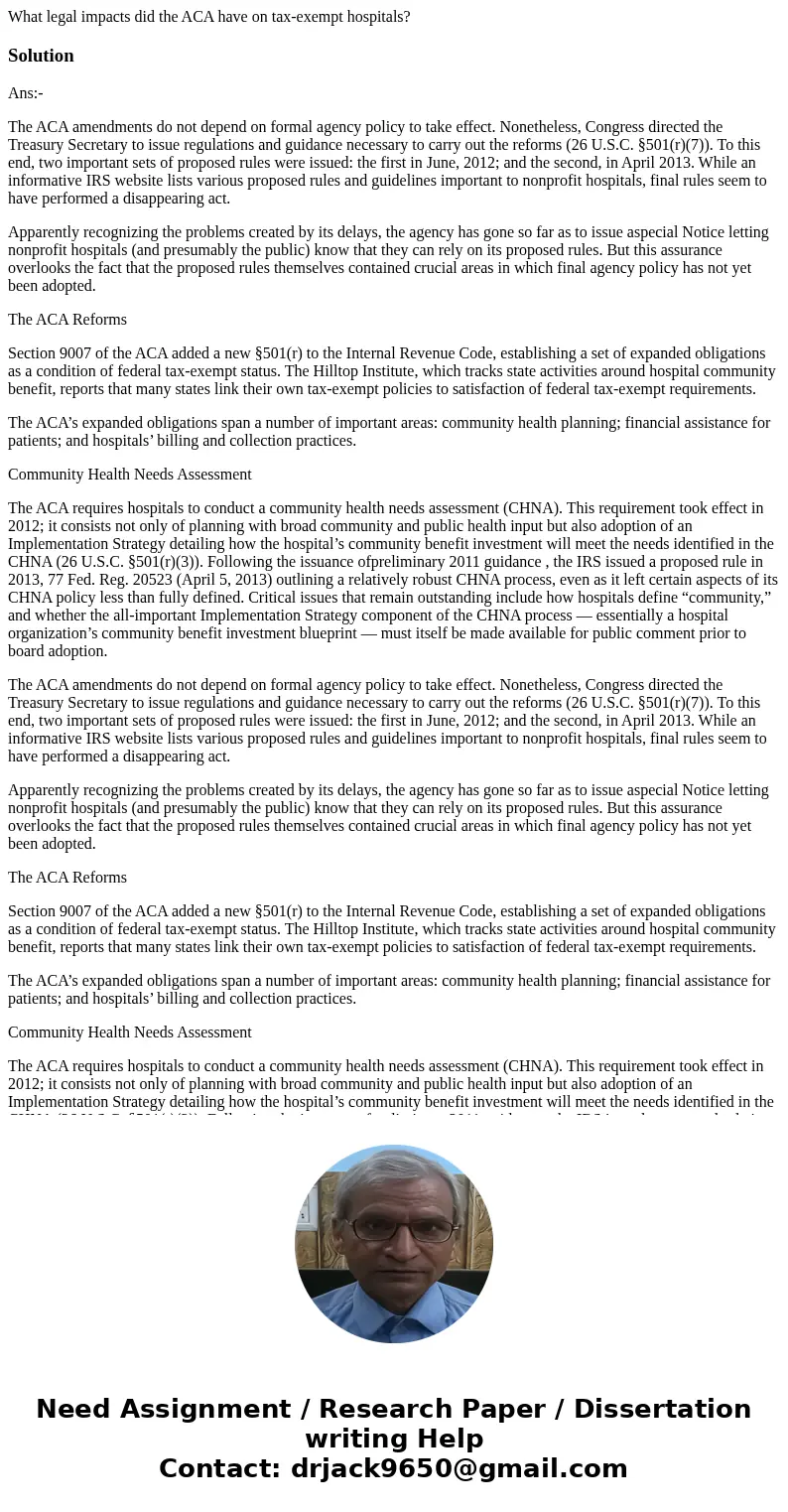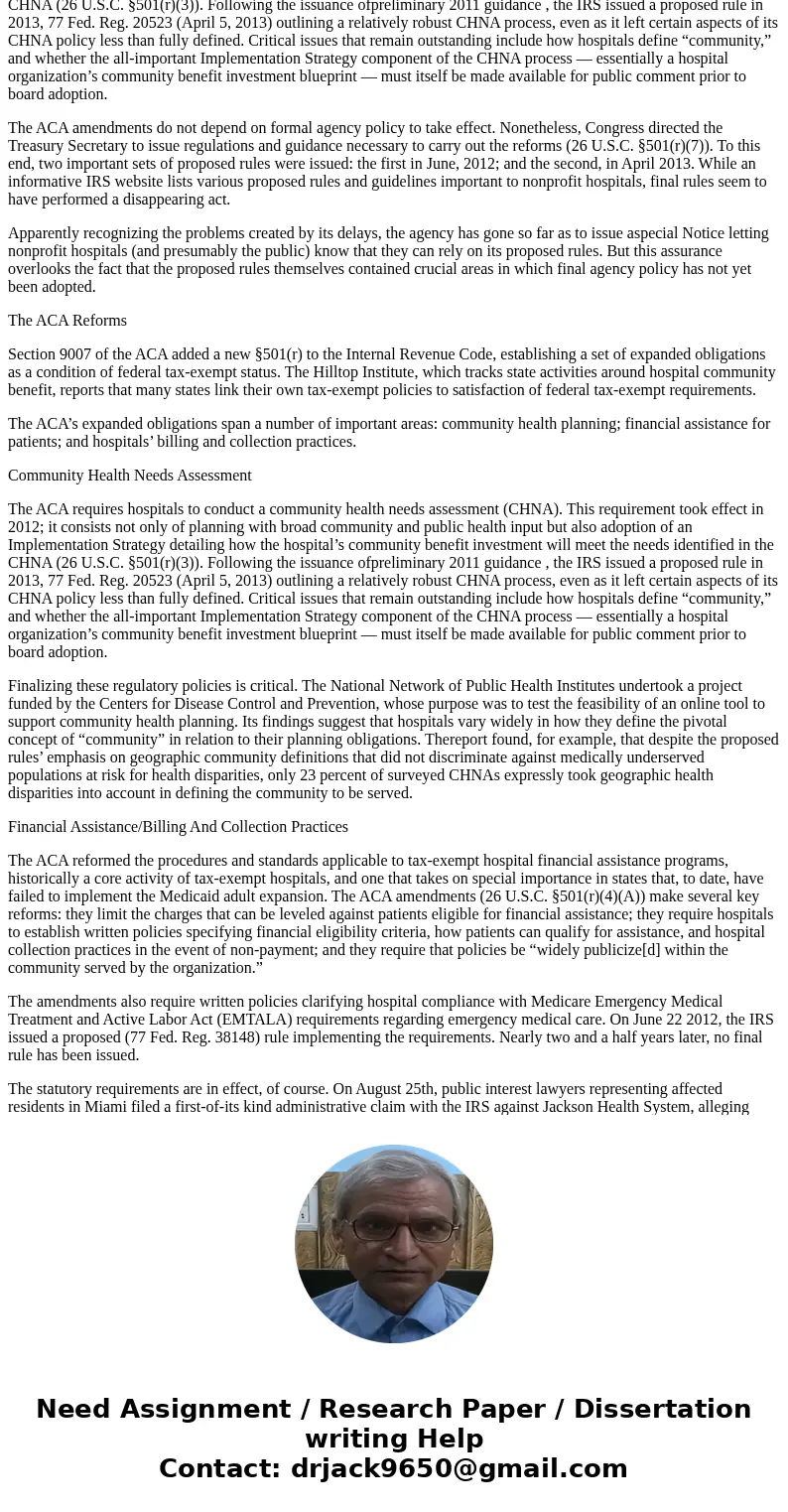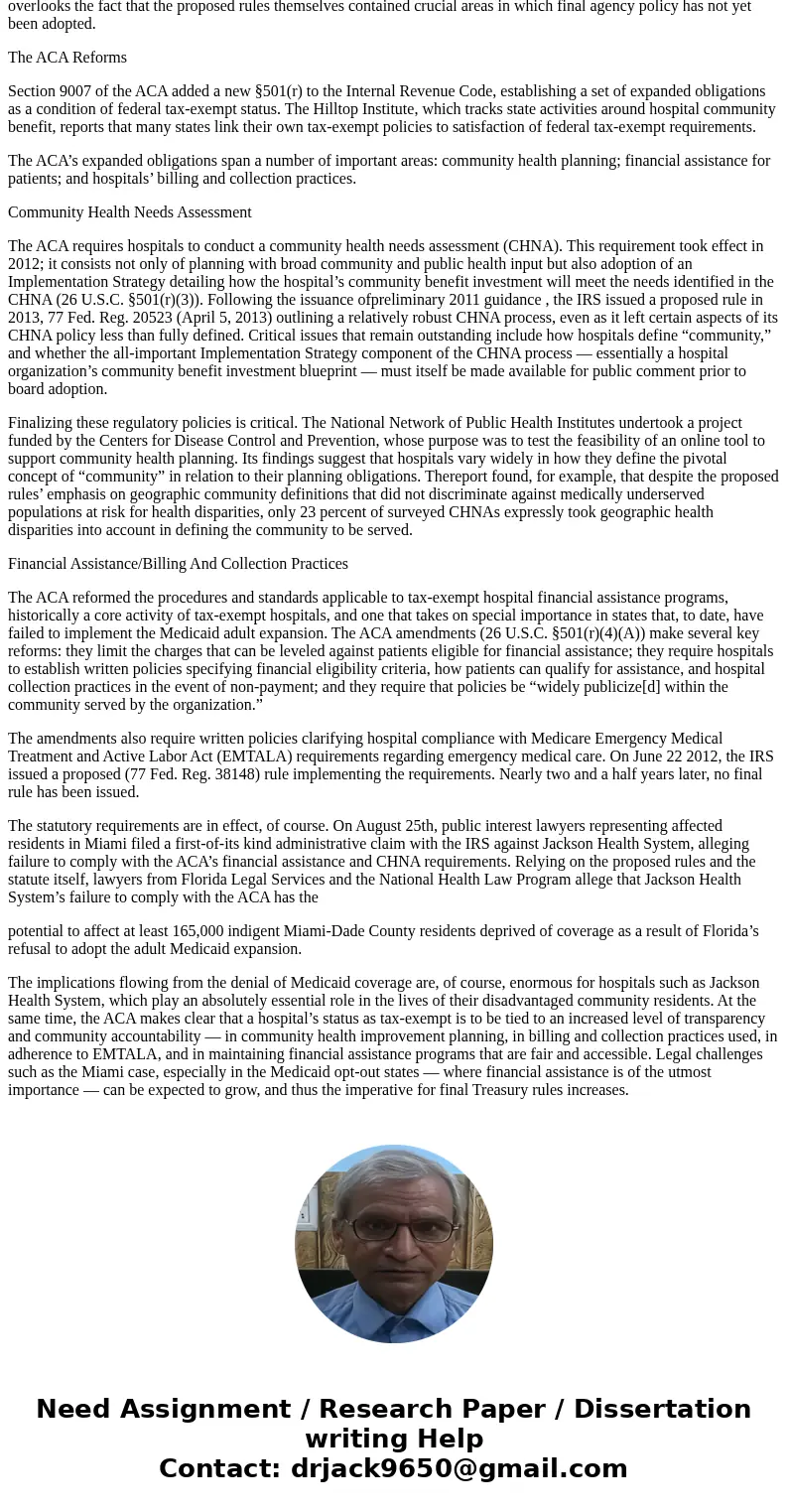What legal impacts did the ACA have on taxexempt hospitalsSo
What legal impacts did the ACA have on tax-exempt hospitals?
Solution
Ans:-
The ACA amendments do not depend on formal agency policy to take effect. Nonetheless, Congress directed the Treasury Secretary to issue regulations and guidance necessary to carry out the reforms (26 U.S.C. §501(r)(7)). To this end, two important sets of proposed rules were issued: the first in June, 2012; and the second, in April 2013. While an informative IRS website lists various proposed rules and guidelines important to nonprofit hospitals, final rules seem to have performed a disappearing act.
Apparently recognizing the problems created by its delays, the agency has gone so far as to issue aspecial Notice letting nonprofit hospitals (and presumably the public) know that they can rely on its proposed rules. But this assurance overlooks the fact that the proposed rules themselves contained crucial areas in which final agency policy has not yet been adopted.
The ACA Reforms
Section 9007 of the ACA added a new §501(r) to the Internal Revenue Code, establishing a set of expanded obligations as a condition of federal tax-exempt status. The Hilltop Institute, which tracks state activities around hospital community benefit, reports that many states link their own tax-exempt policies to satisfaction of federal tax-exempt requirements.
The ACA’s expanded obligations span a number of important areas: community health planning; financial assistance for patients; and hospitals’ billing and collection practices.
Community Health Needs Assessment
The ACA requires hospitals to conduct a community health needs assessment (CHNA). This requirement took effect in 2012; it consists not only of planning with broad community and public health input but also adoption of an Implementation Strategy detailing how the hospital’s community benefit investment will meet the needs identified in the CHNA (26 U.S.C. §501(r)(3)). Following the issuance ofpreliminary 2011 guidance , the IRS issued a proposed rule in 2013, 77 Fed. Reg. 20523 (April 5, 2013) outlining a relatively robust CHNA process, even as it left certain aspects of its CHNA policy less than fully defined. Critical issues that remain outstanding include how hospitals define “community,” and whether the all-important Implementation Strategy component of the CHNA process — essentially a hospital organization’s community benefit investment blueprint — must itself be made available for public comment prior to board adoption.
The ACA amendments do not depend on formal agency policy to take effect. Nonetheless, Congress directed the Treasury Secretary to issue regulations and guidance necessary to carry out the reforms (26 U.S.C. §501(r)(7)). To this end, two important sets of proposed rules were issued: the first in June, 2012; and the second, in April 2013. While an informative IRS website lists various proposed rules and guidelines important to nonprofit hospitals, final rules seem to have performed a disappearing act.
Apparently recognizing the problems created by its delays, the agency has gone so far as to issue aspecial Notice letting nonprofit hospitals (and presumably the public) know that they can rely on its proposed rules. But this assurance overlooks the fact that the proposed rules themselves contained crucial areas in which final agency policy has not yet been adopted.
The ACA Reforms
Section 9007 of the ACA added a new §501(r) to the Internal Revenue Code, establishing a set of expanded obligations as a condition of federal tax-exempt status. The Hilltop Institute, which tracks state activities around hospital community benefit, reports that many states link their own tax-exempt policies to satisfaction of federal tax-exempt requirements.
The ACA’s expanded obligations span a number of important areas: community health planning; financial assistance for patients; and hospitals’ billing and collection practices.
Community Health Needs Assessment
The ACA requires hospitals to conduct a community health needs assessment (CHNA). This requirement took effect in 2012; it consists not only of planning with broad community and public health input but also adoption of an Implementation Strategy detailing how the hospital’s community benefit investment will meet the needs identified in the CHNA (26 U.S.C. §501(r)(3)). Following the issuance ofpreliminary 2011 guidance , the IRS issued a proposed rule in 2013, 77 Fed. Reg. 20523 (April 5, 2013) outlining a relatively robust CHNA process, even as it left certain aspects of its CHNA policy less than fully defined. Critical issues that remain outstanding include how hospitals define “community,” and whether the all-important Implementation Strategy component of the CHNA process — essentially a hospital organization’s community benefit investment blueprint — must itself be made available for public comment prior to board adoption.
The ACA amendments do not depend on formal agency policy to take effect. Nonetheless, Congress directed the Treasury Secretary to issue regulations and guidance necessary to carry out the reforms (26 U.S.C. §501(r)(7)). To this end, two important sets of proposed rules were issued: the first in June, 2012; and the second, in April 2013. While an informative IRS website lists various proposed rules and guidelines important to nonprofit hospitals, final rules seem to have performed a disappearing act.
Apparently recognizing the problems created by its delays, the agency has gone so far as to issue aspecial Notice letting nonprofit hospitals (and presumably the public) know that they can rely on its proposed rules. But this assurance overlooks the fact that the proposed rules themselves contained crucial areas in which final agency policy has not yet been adopted.
The ACA Reforms
Section 9007 of the ACA added a new §501(r) to the Internal Revenue Code, establishing a set of expanded obligations as a condition of federal tax-exempt status. The Hilltop Institute, which tracks state activities around hospital community benefit, reports that many states link their own tax-exempt policies to satisfaction of federal tax-exempt requirements.
The ACA’s expanded obligations span a number of important areas: community health planning; financial assistance for patients; and hospitals’ billing and collection practices.
Community Health Needs Assessment
The ACA requires hospitals to conduct a community health needs assessment (CHNA). This requirement took effect in 2012; it consists not only of planning with broad community and public health input but also adoption of an Implementation Strategy detailing how the hospital’s community benefit investment will meet the needs identified in the CHNA (26 U.S.C. §501(r)(3)). Following the issuance ofpreliminary 2011 guidance , the IRS issued a proposed rule in 2013, 77 Fed. Reg. 20523 (April 5, 2013) outlining a relatively robust CHNA process, even as it left certain aspects of its CHNA policy less than fully defined. Critical issues that remain outstanding include how hospitals define “community,” and whether the all-important Implementation Strategy component of the CHNA process — essentially a hospital organization’s community benefit investment blueprint — must itself be made available for public comment prior to board adoption.
Finalizing these regulatory policies is critical. The National Network of Public Health Institutes undertook a project funded by the Centers for Disease Control and Prevention, whose purpose was to test the feasibility of an online tool to support community health planning. Its findings suggest that hospitals vary widely in how they define the pivotal concept of “community” in relation to their planning obligations. Thereport found, for example, that despite the proposed rules’ emphasis on geographic community definitions that did not discriminate against medically underserved populations at risk for health disparities, only 23 percent of surveyed CHNAs expressly took geographic health disparities into account in defining the community to be served.
Financial Assistance/Billing And Collection Practices
The ACA reformed the procedures and standards applicable to tax-exempt hospital financial assistance programs, historically a core activity of tax-exempt hospitals, and one that takes on special importance in states that, to date, have failed to implement the Medicaid adult expansion. The ACA amendments (26 U.S.C. §501(r)(4)(A)) make several key reforms: they limit the charges that can be leveled against patients eligible for financial assistance; they require hospitals to establish written policies specifying financial eligibility criteria, how patients can qualify for assistance, and hospital collection practices in the event of non-payment; and they require that policies be “widely publicize[d] within the community served by the organization.”
The amendments also require written policies clarifying hospital compliance with Medicare Emergency Medical Treatment and Active Labor Act (EMTALA) requirements regarding emergency medical care. On June 22 2012, the IRS issued a proposed (77 Fed. Reg. 38148) rule implementing the requirements. Nearly two and a half years later, no final rule has been issued.
The statutory requirements are in effect, of course. On August 25th, public interest lawyers representing affected residents in Miami filed a first-of-its kind administrative claim with the IRS against Jackson Health System, alleging failure to comply with the ACA’s financial assistance and CHNA requirements. Relying on the proposed rules and the statute itself, lawyers from Florida Legal Services and the National Health Law Program allege that Jackson Health System’s failure to comply with the ACA has the
potential to affect at least 165,000 indigent Miami-Dade County residents deprived of coverage as a result of Florida’s refusal to adopt the adult Medicaid expansion.
The implications flowing from the denial of Medicaid coverage are, of course, enormous for hospitals such as Jackson Health System, which play an absolutely essential role in the lives of their disadvantaged community residents. At the same time, the ACA makes clear that a hospital’s status as tax-exempt is to be tied to an increased level of transparency and community accountability — in community health improvement planning, in billing and collection practices used, in adherence to EMTALA, and in maintaining financial assistance programs that are fair and accessible. Legal challenges such as the Miami case, especially in the Medicaid opt-out states — where financial assistance is of the utmost importance — can be expected to grow, and thus the imperative for final Treasury rules increases.



 Homework Sourse
Homework Sourse